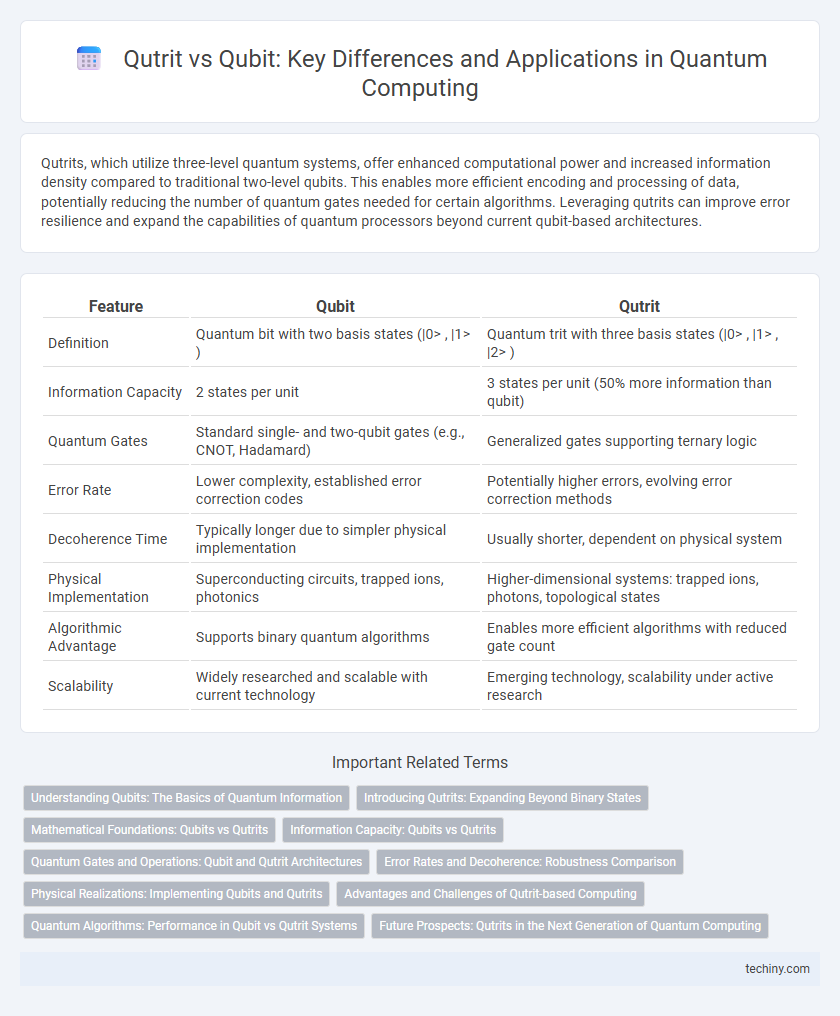Qutrits, which utilize three-level quantum systems, offer enhanced computational power and increased information density compared to traditional two-level qubits. This enables more efficient encoding and processing of data, potentially reducing the number of quantum gates needed for certain algorithms. Leveraging qutrits can improve error resilience and expand the capabilities of quantum processors beyond current qubit-based architectures.
Table of Comparison
| Feature | Qubit | Qutrit |
|---|---|---|
| Definition | Quantum bit with two basis states (|0> , |1> ) | Quantum trit with three basis states (|0> , |1> , |2> ) |
| Information Capacity | 2 states per unit | 3 states per unit (50% more information than qubit) |
| Quantum Gates | Standard single- and two-qubit gates (e.g., CNOT, Hadamard) | Generalized gates supporting ternary logic |
| Error Rate | Lower complexity, established error correction codes | Potentially higher errors, evolving error correction methods |
| Decoherence Time | Typically longer due to simpler physical implementation | Usually shorter, dependent on physical system |
| Physical Implementation | Superconducting circuits, trapped ions, photonics | Higher-dimensional systems: trapped ions, photons, topological states |
| Algorithmic Advantage | Supports binary quantum algorithms | Enables more efficient algorithms with reduced gate count |
| Scalability | Widely researched and scalable with current technology | Emerging technology, scalability under active research |
Understanding Qubits: The Basics of Quantum Information
Qubits, the fundamental units of quantum information, represent binary states 0 and 1 simultaneously through superposition, enabling exponential computational power compared to classical bits. Unlike qubits, qutrits utilize three quantum states--0, 1, and 2--offering higher dimensionality and potentially increased information density in quantum systems. Understanding the basic properties of qubits, including coherence, entanglement, and quantum gate operations, is essential for advancing quantum computing architectures and algorithms.
Introducing Qutrits: Expanding Beyond Binary States
Qutrits extend quantum computing beyond the traditional binary framework of qubits by utilizing three-level quantum systems, which enables higher information density and more complex quantum operations. These three-level quantum units can represent states |0> , |1> , and |2> , offering increased computational power and error resilience. Incorporating qutrits into quantum algorithms allows for enhanced data encoding and potentially more efficient quantum circuit designs.
Mathematical Foundations: Qubits vs Qutrits
Qubits, representing binary states |0> and |1> , operate within a two-dimensional Hilbert space, allowing computation through linear superposition and entanglement formulated by Pauli matrices and Bloch spheres. Qutrits extend these principles into a three-dimensional Hilbert space with states |0> , |1> , and |2> , leveraging SU(3) Lie algebra and Gell-Mann matrices to enable richer quantum operations and higher information density per quantum unit. The mathematical distinction between qubits and qutrits enhances computational complexity, error resilience, and algorithmic design in quantum information processing.
Information Capacity: Qubits vs Qutrits
Qutrits, representing three-level quantum systems, inherently carry more information than qubits by encoding log2(3) 1.585 bits compared to the single bit encoded by qubits, enhancing computational density. This increased information capacity enables qutrit-based quantum processors to perform more complex operations using fewer quantum units, potentially reducing error rates and improving efficiency. Leveraging qutrits can lead to advancements in quantum algorithms and error correction techniques due to their higher dimensional state space.
Quantum Gates and Operations: Qubit and Qutrit Architectures
Quantum gates for qubits operate on two-level systems using Pauli matrices and unitary transformations, enabling superposition and entanglement with standard gate sets like Hadamard and CNOT. Qutrit architectures extend these operations to three-level quantum systems, employing generalized unitary operators and qutrit-specific gates such as the ternary X and Z gates to exploit higher-dimensional Hilbert spaces. This increased dimensionality in qutrits offers more complex quantum operations and potentially higher computational density per physical quantum element.
Error Rates and Decoherence: Robustness Comparison
Qutrits exhibit lower error rates and enhanced resistance to decoherence compared to qubits due to their higher-dimensional state space, which allows more complex error-correcting codes and improved noise tolerance. Experimental studies demonstrate that qutrit systems maintain coherence over longer periods, reducing the impact of environmental disturbances typical in quantum processing. This robustness positions qutrits as promising candidates for scalable quantum computing architectures where minimizing error rates and decoherence is critical.
Physical Realizations: Implementing Qubits and Qutrits
Physical realizations of qubits commonly utilize superconducting circuits and trapped ions, enabling two-level quantum state control. Qutrits expand this framework by leveraging three-level quantum systems, often implemented through atomic energy levels or photonic modes, offering increased computational capacity per unit. Implementing qutrits requires more complex control techniques for coherent manipulation, but provides advantages in error resistance and information density compared to qubit systems.
Advantages and Challenges of Qutrit-based Computing
Qutrit-based computing offers enhanced computational power by leveraging three-level quantum systems, enabling more complex calculations and improved error resilience compared to traditional qubit-based systems. The increased state space of qutrits allows for more efficient quantum algorithms and reduced gate operations, potentially accelerating quantum processing tasks. However, challenges include the need for advanced control techniques to manipulate qutrit states accurately and the complexity of designing hardware that supports stable three-level quantum systems.
Quantum Algorithms: Performance in Qubit vs Qutrit Systems
Qutrit systems offer a higher-dimensional state space than qubits, enabling more complex quantum algorithms to be executed with potentially fewer operations. This dimensional advantage can enhance algorithmic performance by reducing gate depth and error rates in certain quantum computations. Experimental results demonstrate that quantum algorithms leveraging qutrits achieve improved efficiency and robustness compared to their qubit counterparts in tasks such as quantum Fourier transforms and error correction protocols.
Future Prospects: Qutrits in the Next Generation of Quantum Computing
Qutrits offer a promising advancement for future quantum computing by utilizing three-level quantum systems, which increase computational complexity and information density compared to traditional qubits. Their enhanced state space enables more efficient quantum algorithms, error correction, and noise resilience, crucial for scaling quantum processors. As research progresses, qutrit-based architectures could significantly outperform qubit-only systems in speed and capacity, driving next-generation quantum technologies.
qutrit vs qubit Infographic

 techiny.com
techiny.com